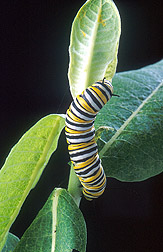
People from all over have become more aware of the monarchs and their journey from Mexico to the Gulf of Mexico to points north - since 1975 when the stories came out about their wintering habitats. I've seen them hanging around on the shoreline of Bear Island in Lake Michigan and along the shore of Lac des Deux-Montagnes - part of the St. Lawrence Lowlands near Montreal - among other places.
Canada has 3 butterfly sanctuaries in Southern Ontario - at Point Pelee, Long Point and Prince Edward Point parks. Though, of course, the butterflies go where they feel like going.
From the CBC :
Butterfly counters in central Connecticut, Martha's Vineyard and upstate New York were all reporting larger sightings of monarchs this year than last, though still down by historical levels. (Bog coppers and painted ladies didn't appear to be doing so well, on the other hand.)
...At the moment, there are by most estimates tens of millions of monarchs flapping north or south, depending on the time of year. They've shown a remarkable ability to bounce back after vast numbers — sometimes as much as 90 per cent — have been wiped out by natural disaster.
But biologists note that the western monarchs are down to only a few million or so butterflies because of widespread farming changes that drastically reduced their main food supply.
I've gotten to noticing that in late August the monarchs travel through Indiana. I have also noticed that they like the Mexican Sunflower (Tithonia rotundifolia)- when I've managed to grow them. I think the flowers preferred the sandier soil where I used to live.
Milkweed is what is required for the monarchs to lay their eggs on and for the larva to feed on. (For other plants to grow for various kinds of butterflies - see this chart). One generation lasts 7-8 months - the one that flies from their summer homes to their winter homes and the first leg back up north. Then there are a succession of 4-5 week generations - that are dependant on finding milkweed.
It's an amazing thing that just 30 years ago - the world found out about the monarch butterflies winter home in Mexico - where they group together in trees. The local people knew about them, of course. It seems that at the same time the world found out about the monarch's home, the people there found out about the rest of the world.
A 1986 Presidential Decree by the Mexican government created the Monarch Butterfly Special Biosphere Reserve covering 62 square miles....In November 2000, the Monarch Butterfly Biosphere Reserve was expanded from 62 to 217 square miles. The declaration of the new Reserve was accompanied by a financial plan that provides economic support to communities for lost income from logging, as well as for their conservation endeavors.
There has been a multimillion dollar campaign to protect the Monarch's wintering habitat. One of the problems has been "organized crime in the form of armed, illegal logging gangs".
People from Mexican, U.S. and Canadian governments met in May and created a plan - The Trilateral Monarch Butterfly Sister Protected Area Network - to designate 13 protected areas on the monarchs migration route and to share data and such.
Monarch researcher and ecologist Dr. Lincoln Brower said said, "I think it will make a good symbolic statement."
But Brower said the agreement will do little to preserve the butterflies unless stronger action is also taken to stop logging in Mexico and to change farming practices in the United States that are destroying the plants the butterflies rely on.
See also monarchwatch.org
1 comment:
I have seen lots of monarchs in Connecticut this month. I did not know they came this far East.
Post a Comment